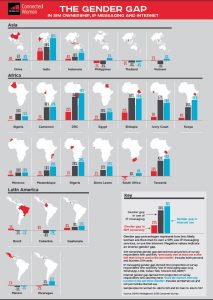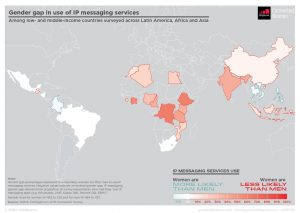Research by GSMA Intelligence reveals the extent of the gender gap in mobile ownership, IP messaging (e.g. Whatsapp) and general internet use across a suite of low- and middle-income countries in Asia, Africa and Latin America.
Of the countries surveyed in this study, the largest gender gaps appear to be in India and various African markets.
Findings resonate with previous GSMA Connected Women research, which also highlighted how the gender gap in mobile usage is usually even greater than the gender gap in mobile ownership, and particularly for more sophisticated services such as mobile internet. In DRC, for instance, the GSMA Intelligence study suggests that women are 22 per cent less likely than men to own a mobile phone, 64 per cent less likely to use IP messaging, and 75 per cent less likely to use the internet (including mobile internet, PCs and other sources of access).
Even when countries appear to have a small gender gap or no gender gap at all, deeper analysis can reveal higher gender gaps among certain areas of the country or age groups. In Morocco, for instance, the average country-wide gender gap of 4 per cent in mobile phone ownership is predominantly driven by rural areas, where women are 12 per cent less likely to own a mobile phone than men. In urban areas, men and women have a similar level of mobile ownership.
On a more positive note, a few countries appear to have no obvious gender gaps, at least at the national level. More research is needed to understand why markets such as Thailand, Brazil and the Philippines appear relatively progressive in this regard.
The Whatsapp gap
Although Whatsapp has now reached over 1 billion users around the world, findings from this survey suggest that – in low- and middle-income countries at least – most of these users are likely to be men.
The gender gap in IP messaging use (including Whatsapp) among the surveyed countries is highest in most African markets such as DRC, Ethiopia and Ivory Coast, and also India, where women are 38 per cent less likely to use IP messaging than men, and 50 per cent less likely in rural areas.
The opportunity
Ensuring women use IP messaging and other mobile services on par with men represents an attractive commercial opportunity for the mobile industry. GSMA Connected Women estimate that closing the gender gap in mobile access and use across low- and middle-income countries represents a cumulative revenue opportunity of USD 170 billion for mobile operators over the period 2015-2020 . Closing the digital gender gap can also enable women to feel more connected, safer, and access vital information and services relating to health, their finances and livelihoods.



